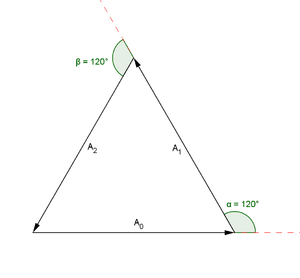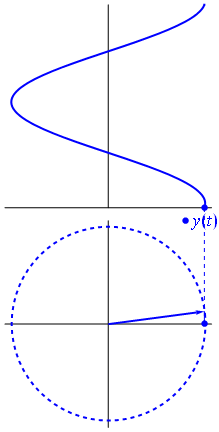Phasor facts for kids
A phasor is a special mathematical tool. Think of it like a spinning arrow that helps us understand things that change in a regular, wave-like way. It's super useful in mathematics and especially in electricity, where it helps make complicated calculations much simpler.
Imagine electricity flowing in your home. It doesn't just flow steadily; it wiggles back and forth like a wave. This is called AC electricity. Phasors help us see how different parts of an electrical circuit, like resistors, inductors, and capacitors, affect this wiggling flow.
Contents
What is a Wave?
Waves are everywhere! You can see them in the ocean, hear them as sound, and even feel them as light. A wave is something that moves up and down or back and forth in a repeating pattern.
In electricity, the voltage and current can act like waves. They go up, then down, then up again, over and over. Phasors help us keep track of these repeating patterns.
Why Use Phasors?
Working with waves directly can be tricky because they are always changing. Phasors turn these changing waves into simple, steady arrows. This makes it much easier to add or subtract different waves, especially when dealing with AC circuits.
Instead of complex wave equations, we can use simple geometry with these arrows. It's like turning a moving picture into a still snapshot that's easier to analyze.
How Phasors Work
Imagine an arrow spinning around a central point, like the hands on a clock.
- The length of the arrow tells us the maximum size or strength of the wave (like how high a water wave gets). This is called its magnitude.
- The angle of the arrow tells us where the wave is in its cycle at a specific moment. This is called its phase.
As the arrow spins, it represents the wave's changing value over time. We usually look at the arrow's position at a specific starting point, like when time is zero.
The Spinning Arrow
A phasor is like a snapshot of a spinning arrow. The arrow's length shows how strong the wave is. Its angle shows its starting position or "phase."
When we talk about the "phase" of a wave, we mean its position in its cycle. Think of two people swinging on swings. If they swing exactly together, they are "in phase." If one is at the top while the other is at the bottom, they are "out of phase."
Real and Imaginary Parts
Phasors use a special kind of number system called complex numbers. This system has a "real" part and an "imaginary" part.
- The real part is like the horizontal axis on a graph.
- The imaginary part is like the vertical axis.
Electronic parts like resistors, inductors, and capacitors affect the "phase" of electricity differently, which means they affect the real and imaginary parts of the phasor.
Phasors in Electrical Circuits
Phasors are super helpful for understanding how different parts of an electrical circuit behave with AC electricity.
- Resistors: These parts resist the flow of electricity. They don't change the phase of the wave. So, their phasor points along the "real" axis, with a 0-degree phase angle.
- Inductors: These parts store energy in a magnetic field. They cause the current wave to lag behind the voltage wave by 90 degrees. Their phasor points along the positive "imaginary" axis (+90 degrees).
- Capacitors: These parts store energy in an electric field. They cause the current wave to lead the voltage wave by 90 degrees. Their phasor points along the negative "imaginary" axis (-90 degrees).
By using phasors, engineers can easily see how these different components affect the overall flow of electricity in a circuit. They can add and subtract these spinning arrows to figure out the total effect.
Adding Phasors
One of the coolest things about phasors is how easy it is to add them. If you have two waves, you can represent each as a phasor (an arrow). To find the total wave, you just add the arrows together, head-to-tail, like you might have done in a math class. The resulting arrow is the phasor for the combined wave. This makes solving complex electrical problems much simpler!
Images for kids
See also
 In Spanish: Fasor para niños
In Spanish: Fasor para niños






